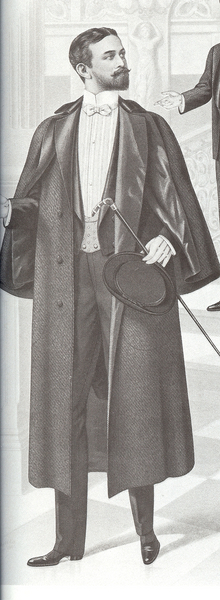Overcoat
Overcoat is a long, substantial coat worn over clothing to protect the wearer from cold, rain, and other extreme weather conditions. Overcoats are most commonly used in winter and are often made from heavy wool, cashmere, or other warm fabrics. The design of an overcoat can vary widely, from single-breasted to double-breasted, and can include features such as notched lapels, belts, and various types of collars and pockets.
History[edit | edit source]
The overcoat has a rich history that dates back several centuries. Initially, overcoats were designed for functionality, to protect against the cold and inclement weather. Over time, they evolved into fashion statements, with variations in style, length, and material reflecting changes in fashion and social status. The 19th century saw the rise of distinct overcoat styles such as the Chesterfield, the Ulster, and the Paletot, each with unique features and associated with different levels of society and occasions.
Types of Overcoats[edit | edit source]
There are several types of overcoats, each with its own characteristics and uses:
- Chesterfield Coat: A long, tailored overcoat that is often single-breasted and made of wool or cashmere. It is distinguished by its lack of a waist seam, making it a popular choice for formal occasions.
- Trench Coat: Originally developed for military use during World War I, the trench coat is a waterproof, lightweight overcoat with a belt at the waist. It has become a timeless piece in both men's and women's fashion.
- Pea Coat: A shorter type of overcoat, typically made of heavy wool, with a double-breasted front and broad lapels. Originally worn by sailors, pea coats are now a common winter garment for the general public.
- Duffle Coat: Characterized by its toggle closures, hood, and woolen fabric, the duffle coat offers a casual and warm option for cold weather. It is named after the duffle fabric it was originally made from.
Choosing an Overcoat[edit | edit source]
When selecting an overcoat, several factors should be considered to ensure both comfort and style:
- Material: Wool, cashmere, and wool blends offer warmth and durability, while synthetic fabrics can provide waterproofing and additional wind protection.
- Length: Overcoat lengths can vary from thigh-length to below the knee, and the choice often depends on personal preference and the level of warmth required.
- Style: The overcoat should complement the wearer's existing wardrobe and be appropriate for the occasions it will be worn, whether formal or casual.
- Fit: A well-fitting overcoat should allow for layers underneath without being too bulky or restrictive.
Care and Maintenance[edit | edit source]
Proper care and maintenance are essential to extend the life of an overcoat. Regular brushing, airing out, and spot cleaning can help maintain the coat's appearance. It is also recommended to have the overcoat professionally cleaned at least once a season, depending on usage.
Cultural Significance[edit | edit source]
Overcoats have also played a significant role in popular culture, symbolizing various characters and periods in history. They have been featured prominently in literature, film, and television, often used to define characters and convey a sense of mystery, sophistication, or authority.
Search WikiMD
Ad.Tired of being Overweight? Try W8MD's physician weight loss program.
Semaglutide (Ozempic / Wegovy and Tirzepatide (Mounjaro / Zepbound) available.
Advertise on WikiMD
|
WikiMD's Wellness Encyclopedia |
| Let Food Be Thy Medicine Medicine Thy Food - Hippocrates |
Translate this page: - East Asian
中文,
日本,
한국어,
South Asian
हिन्दी,
தமிழ்,
తెలుగు,
Urdu,
ಕನ್ನಡ,
Southeast Asian
Indonesian,
Vietnamese,
Thai,
မြန်မာဘာသာ,
বাংলা
European
español,
Deutsch,
français,
Greek,
português do Brasil,
polski,
română,
русский,
Nederlands,
norsk,
svenska,
suomi,
Italian
Middle Eastern & African
عربى,
Turkish,
Persian,
Hebrew,
Afrikaans,
isiZulu,
Kiswahili,
Other
Bulgarian,
Hungarian,
Czech,
Swedish,
മലയാളം,
मराठी,
ਪੰਜਾਬੀ,
ગુજરાતી,
Portuguese,
Ukrainian
Medical Disclaimer: WikiMD is not a substitute for professional medical advice. The information on WikiMD is provided as an information resource only, may be incorrect, outdated or misleading, and is not to be used or relied on for any diagnostic or treatment purposes. Please consult your health care provider before making any healthcare decisions or for guidance about a specific medical condition. WikiMD expressly disclaims responsibility, and shall have no liability, for any damages, loss, injury, or liability whatsoever suffered as a result of your reliance on the information contained in this site. By visiting this site you agree to the foregoing terms and conditions, which may from time to time be changed or supplemented by WikiMD. If you do not agree to the foregoing terms and conditions, you should not enter or use this site. See full disclaimer.
Credits:Most images are courtesy of Wikimedia commons, and templates, categories Wikipedia, licensed under CC BY SA or similar.
Contributors: Prab R. Tumpati, MD






